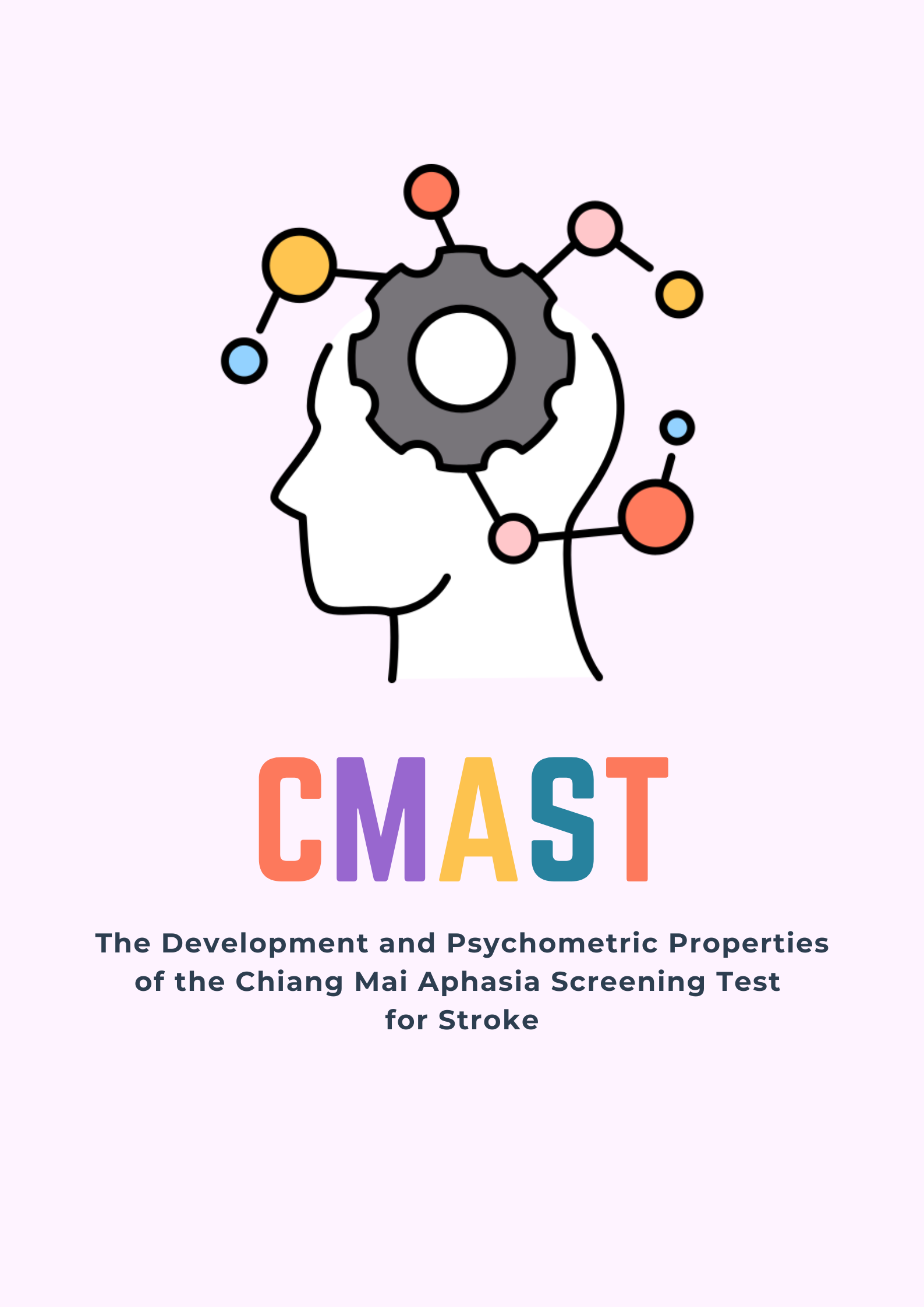The development and psychometric properties of the Chiang Mai Aphasia Screening Test for stroke
Main Article Content
Abstract
Background: The aphasia screening test detects language and speech impairments, clarifying individuals’ language and speech abilities before administering a standardized aphasia diagnosis test.
Objective: This study aimed to develop and validate an aphasia screening test for suspected cerebrovascular accident (CVA) patients with communication difficulties.
Materials and methods: The study underwent two phases: developing and assessing psychometric properties. Five experts established content validity across receptive language, expressive language, reading, and writing. The Chiang Mai Aphasia Screening Test (CMAST) was evaluated on 14 CVA patients with and 14 without aphasia.
Results: The content validity showed item-objective congruence ranging from 0.80 to 1.00. Sensitivity and specificity were 96.30% and 69%, respectively, with a maximum Youden’s Index at 65.30% and a cut-off point of 43 points. Concurrent validity was high (phi coefficient =0.67), and significant score differences (p<0.001) in construct validity confirmed the tool’s ability to distinguish aphasic from non-aphasic patients. Inter-rater reliability (ICC=0.99) and internal consistency (Cronbach’s alpha =0.97, 95% CI 0.95-0.98) were observed.
Conclusion: The CMAST, comprising 45 items, exhibits sufficient validity and reliability for screening individuals suspected of aphasia due to CVA.
Article Details

This work is licensed under a Creative Commons Attribution-NonCommercial-NoDerivatives 4.0 International License.
Personal views expressed by the contributors in their articles are not necessarily those of the Journal of Associated Medical Sciences, Faculty of Associated Medical Sciences, Chiang Mai University.
References
Owens REJ. Introduction to communication disorders: a lifespan evidence-based perspective. 4thEd. Boston: Pearson Education; 2011.
Cherney LR, Patterson JP, Raymer AM. Intensity of aphasia therapy: evidence and efficacy. Curr Neurol Neurosci Rep. 2011; 11(6): 560-9. doi: 10.1007/s11910-011-0227-6.
Rhea P, Norbury C, Gosse C. Language disorders from infancy through adolescence: listening, speaking, reading, writing, and communicating. 5th Ed. Maryland Heights, MO: Elsevier/Mosby; 2018.
Ministry of Public Health. Number and rate of stroke patients in the years 2016-2018. In: Noncommunicable diseases division, Ed. 2019.
Enderby P, Crow E. Frenchay Aphasia Screening Test: validity and comparability. Disabil Rehabil. 1996; 18(5): 238-40. doi: 10.3109/09638289609166307.
Enderby PM, Wood VA, Wade DT, Hewer RL. The Frenchay Aphasia Screening Test: a short, simple test for aphasia appropriate for non-specialists. Int Rehabil Med. 1987; 8(4): 166-70. doi: 10.3109/03790798709166209.
Nakase-Thompson R, Manning E, Sherer M, Yablon S, Gontkovsky S, Vickery C. Brief assessment of severe language impairments: initial validation of the Mississippi aphasia screening test. Brain Inj. 2005; 19(9): 685-91. doi: 10.1080/02699050400025331.
Doesborgh SJ, van de Sandt-Koenderman WM, Dippel DW, van Harskamp F, Koudstaal PJ, Visch-Brink EG. Linguistic deficits in the acute phase of stroke. J Neurol. 2003; 250(8): 977-82. doi: 10.1007/s00415-003-1134-9.
El Hachioui H, Van de Sandt-Koenderman M, Dippel D, Koudstaal P, Visch-Brink E. The ScreeLing: occurrence of linguistic deficits in acute aphasia post-stroke. J Rehabil Med. 2012; 44: 429-35. doi: 10.2340/16501977-0955.
Thommessen B, Thoresen GE, Bautz-Holter E, Laake K. Screening by nurses for aphasia in stroke-the Ullevaal Aphasia Screening (UAS) test. Disabil Rehabil. 1999; 21(3): 110-5. doi: 10.1080/096382899297846.
El Hachioui H, Visch-Brink EG, de Lau LM, van de Sandt-Koenderman MW, Nouwens F, Koudstaal PJ, et al. Screening tests for aphasia in patients with stroke: a systematic review. J Neurol. 2017; 264(2): 211-20. doi: 10.1007/s00415-016-8170-8.
Wilson SM, Eriksson DK, Schneck SM, Lucanie JM. A quick aphasia battery for efficient, reliable, and multidimensional assessment of language function. PLoS One. 2018; 13(2): 1-29. doi: 10.1371/journal.pone.0192773.
Institute of Neurology. Clinical practice guideline for stroke rehabilitation. 3rd Ed. Bangkok: Institute of Neurology; 2016.
Supawatrajarugon R, Lorthanawatthapong P, Euasiriratnaphaisan A. Content validity and reliability of the Saraburi Aphasia Screening Test: SD-SLP-01. In: Proceedings of the annual academic conference 2013, Faculty of Medicine, Srinakharinwirot University; February 3-4, 2014; Nakhon Nayok: Faculty of Medicine, Srinakharinwirot University; 2014.
Chapey R. Language intervention strategies in aphasia and related neurogenic communication disorders. 5th Ed. Philadelphia: Lippincott Williams & Wilkins; 2008.
Supawatrajarugon R, Eua-siriratnaphaisan A. Standardization of the Saraburi Aphasia Screening Test: SD-SLP-01 in stroke patients and control group. In: Proceedings of the annual academic conference 2016, Thai Association of Speech and Hearing Sciences; 2016; Bangkok: Ramada Plaza Menam Riverside Hotel.
Kiran S. What is the nature of poststroke language recovery and reorganization? ISRN Neurol. 2012; 2012: 786872. doi: 10.5402/2012/786872.
Breitenstein C, Martus P, Willmes K, Ziegler W, Baumgaertner A. Intensive speech and language therapy after stroke - Authors’ reply. Lancet. 2017; 390(10091): 228-9. doi: 10.1016/S0140-6736(17)31801-9.
Teerapong W. The comparison of language abilities of Thai aphasic patients and Thai normal subjects by using Thai adaptation of Western Aphasia Battery [thesis]. Nakhon Pathom: Mahidol University; 2000.
Schisterman E, Perkins N, Liu A, et al. Optimal cut-point and its corresponding Youden index to discriminate individuals using pooled blood samples. Epidemiology (Cambridge, Mass) 2005; 16: 73-81. doi: 10.1097/01.ede.0000147512.81966.ba.
Yule GU. On the methods of measuring association between two attributes. J R Stat Soc. 1912; 75(6): 579-652. doi: 10.1111/J.2397-2335.1912.
Cohen RJ, Swerdlik ME. Psychological testing and assessment: An introduction to tests and measurement. 6th Ed. New York: McGraw-Hill; 2005.
Koo TK, Li MY. A guideline of selecting and reporting Intraclass Correlation Coefficients for reliability research. J Chiropr Med. 2016; 15(2): 155-63. doi: 10.1016/j.jcm.2016.02.012.
Gliem J, Gliem R. Calculating, interpreting, and reporting Cronbach’s alpha reliability coefficient for Likert-type scales. In proceedings of Midwest research to practice conference in adults, continuing and community education; 2003 Oct 8-10; Columbus: The Ohio State University; 2003. p.82-8.


